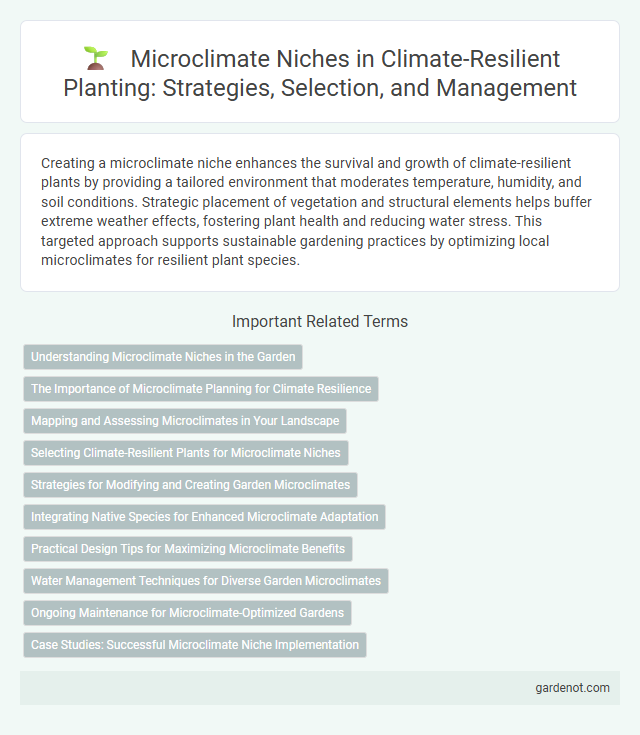Creating a microclimate niche enhances the survival and growth of climate-resilient plants by providing a tailored environment that moderates temperature, humidity, and soil conditions. Strategic placement of vegetation and structural elements helps buffer extreme weather effects, fostering plant health and reducing water stress. This targeted approach supports sustainable gardening practices by optimizing local microclimates for resilient plant species.
Understanding Microclimate Niches in the Garden
Understanding microclimate niches in the garden involves recognizing variations in temperature, humidity, sunlight, and wind patterns within small areas. These microclimates create unique growing conditions that influence plant health, growth rates, and drought resilience. Tailoring plant selection and placement to these specific niches enhances climate-resilient planting success and optimizes resource use.
The Importance of Microclimate Planning for Climate Resilience
Microclimate planning enhances climate resilience by creating localized environments that buffer plants against extreme temperatures, wind, and moisture fluctuations. Strategic use of windbreaks, shading structures, and soil amendments optimizes microclimate conditions, improving plant survival and productivity under climate stress. Incorporating microclimate niches into landscape design supports biodiversity and reduces vulnerability to climate-induced impacts.
Mapping and Assessing Microclimates in Your Landscape
Mapping and assessing microclimates in your landscape involves detailed analysis of temperature, humidity, sunlight exposure, and wind patterns at a localized level. Utilizing tools like GIS mapping, temperature sensors, and soil moisture probes helps identify microclimate niches, enabling precise selection of climate-resilient plants adapted to those specific conditions. Understanding these microclimate variations enhances plant survival, optimizes water use, and improves overall landscape resilience against climate extremes.
Selecting Climate-Resilient Plants for Microclimate Niches
Selecting climate-resilient plants for microclimate niches requires analyzing specific environmental factors such as sunlight exposure, soil type, humidity, and wind patterns unique to each microhabitat. Plants with adaptive traits like drought tolerance, heat resistance, and pest resilience enhance survival and productivity within these localized conditions. Integrating native species that naturally thrive in targeted microclimates promotes ecological balance and long-term sustainability in climate-resilient planting strategies.
Strategies for Modifying and Creating Garden Microclimates
Creating microclimate niches involves strategically positioning plants, structures, and materials to moderate temperature, humidity, and wind exposure, enhancing resilience to climate variability. Techniques such as using windbreaks, shade trees, reflective surfaces, and water features help to create favorable conditions for plant growth and reduce stress from extreme weather. Tailoring these modifications to specific site characteristics optimizes microclimate benefits, promoting sustainable and productive garden ecosystems.
Integrating Native Species for Enhanced Microclimate Adaptation
Integrating native species into microclimate niches enhances climate-resilient planting by leveraging their adaptive traits to local environmental conditions, promoting biodiversity and ecosystem stability. These species improve soil health, water retention, and temperature regulation, creating microhabitats that buffer extreme weather impacts. Strategic selection and placement of native plants optimize microclimate benefits, supporting long-term resilience in shifting climate scenarios.
Practical Design Tips for Maximizing Microclimate Benefits
Strategically positioning plants based on sun exposure, wind patterns, and soil moisture enhances microclimate benefits by creating protective niches that buffer extreme temperatures and conserve water. Incorporating windbreaks such as shrubs or trellises reduces evapotranspiration, while grouping species with complementary needs optimizes resource use and resilience. Mulching and reflective surfaces further moderate soil temperature and moisture, fostering healthier growth and improved climate adaptability.
Water Management Techniques for Diverse Garden Microclimates
Water management techniques tailored for diverse garden microclimates enhance climate-resilient planting by optimizing moisture retention and reducing runoff. Techniques such as mulching, drip irrigation, and rainwater harvesting create microclimate niches that support plant health and conserve water resources. Incorporating soil amendments and strategic plant placement further stabilizes moisture levels, adapting to varying sunlight and wind exposure within the garden.
Ongoing Maintenance for Microclimate-Optimized Gardens
Ongoing maintenance for microclimate-optimized gardens involves regular assessment of soil moisture, shade patterns, and wind exposure to ensure plants thrive in their specific microclimate niches. Targeted irrigation and pruning enhance plant health by maintaining ideal humidity levels and sunlight access, critical for resilience against climate variability. Seasonal monitoring and adaptive care strategies support the long-term stability and productivity of these climate-resilient plantings.
Case Studies: Successful Microclimate Niche Implementation
Case studies of successful microclimate niche implementation demonstrate how strategically selecting plant species tailored to localized environmental conditions enhances climate resilience and crop productivity. Examples from arid regions show that utilizing native drought-tolerant plants within microclimates created by natural landscape features significantly reduces irrigation needs and soil erosion. Urban agriculture projects employing shaded microclimate niches improve temperature regulation and crop yields, highlighting the potential for scalable, climate-adaptive planting solutions.
Microclimate niche Infographic

 gardenot.com
gardenot.com